My six-year-old daughter Sequoia has visited one concentration camp, one border museum, and the Nuremberg Trials memorial museum. I shield her from the most gruesome photos, but explain to her what these places are, what they represent, and why we are there. I am sharing what I tell her, for those parents who find themselves preparing for such trips, in order to present ideas for how to address such topics. Although the holly jolly Christmas season seems like a strange time to bring this up, a lot of people get visitors from abroad over the holidays. If you’re thinking about taking friends and family to any of these types of places and are wondering how you could talk to your children about them during and after your visit, here are some of the ways I addressed the topics. Obviously it is a personal choice whether to take a young child to such places, and one must gauge their individual child’s emotional tolerance and ability to absorb what you are explaining, as well as whether you feel it is beneficial or detrimental to take your child to such museums.
In general, be vigilant. Try to have a parent a few steps ahead to give a signal when the other parent should direct the kids around a more graphic exhibit. It’s easier to explain why people had to wear badges than why they needed that wooden cart to dump the bodies. Be aware of what’s around the corner.
Concentration Camp

Sequoia’s first “What-is-this-place?” visit was to Sachsenhausen, a concentration camp memorial and museum outside of Berlin (visitor information here).
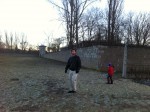
She did not enter all buildings, but she did visit some of the buildings and exhibits. There was a lot of open ground for her to walk around outside when some of us were inside buildings (but remember, at a concentration camp, kids can’t run around being loud—it is a solemn place where people keep a respectful volume; it is one of the only places in Germany I have never seen a game of Fuβball break out).
We explained that there was a time when one group of people did not like another entire group of people just because they were different from them. All of the “different” people were taken and put in these concentration camps. The term “concentration camp” originally confused her since she knew of summer camp (a place I vowed not to send her for at least two years after visiting a concentration camp, for fear there would be some confusion). In all seriousness: be aware that a young child might be making that word association either now, or next summer when you want to send her to day camp. Don’t forget all about your concentration camp visit when you bring up nature camp and she runs to her room screaming.
At these concentration camps, I told her, the “different” people were put to work, and sometimes were beaten up. All because they were different. The reason that we visit this place is to remember that these things have happened, so that we don’t forget that these things can happen, so we don’t let these things happen again. I chose not to mention that these types of things still happen around the world. Baby steps.
Sequoia was five and a half at the time of this visit. I chose not to identify the group of “different” people as Jews. I made that decision because Sequoia had no idea what “Jews” were. She did not categorize people by religion or ethnicity even though she of course noticed differences in skin color, dialect, etc., as anyone does. We answer questions about differences as she notices them; until then, I introduce them as broader concepts. “People who didn’t like people who were different” instead of “The Nazis hated the Jews”. I felt that attempting to explain religion or ethnicity on top of right vs. wrong would detract from what I wanted her to take away from our visit.
I asked Sequoia questions on her level—Isn’t it wrong not to like someone just because they’re different? Isn’t it wrong to hurt someone just because they’re different? Isn’t it wrong to take someone away from their home and put them in jail for being different? Again telling her: we come to places like this so we can remember that bad things happen and talk about them.
We weren’t bitter, didn’t mention hate. I am of the opinion that when a kid sees that people were shoved into jails because they were different, she is able to formulate her own judgments.
Inside exhibits, it is possible to focus a small child’s attention on things like a prisoner’s uniform, a diary that a prisoner kept, etc. You don’t have to let your kid stand and gape at photos. You are in control.
Border Museum
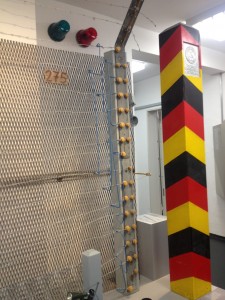
A border museum is less gruesome, but no less confusing. We stumbled upon the Grenslandmuseum Eichsfeld (visitor information here) while staying in a nearby hotel. When the receptionist told me there was a border museum next door, I thought she was a little off in her translation—but it was just that: a museum at one of the East/West German border crossings, keeping alive the memory of the divide. Sequoia could not understand why a wall would be put up to separate two parts of the same country, and politics are a difficult thing to explain. I told her that there were arguments between governments, there had been a war, and someone had separated the land.
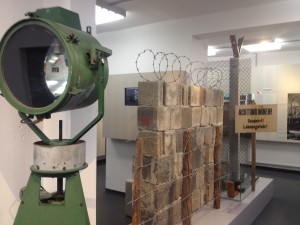
Pictures showed families and loved ones separated by the border. Sequoia did not understand why families would not be allowed to visit one another. I told her that that the wall was put there based on where the land was, and if one part of the family lived on a farm on the left side of the border and another part of the family lived on a farm on the right side of the border, they were separated. I linked this situation to the pieces of wall she had run around on in Berlin, not knowing at the time what they were.
In this border museum, there were quite a few things to focus on for a kid: the kinds of foods and products one side of the border didn’t have access to; what the wall looked like; what the checkpoint was like; a phone and other equipment from the checkpoint; an interactive map; and outdoor exhibits.
Our visit is described within a less serious weekend trip blog entry here; it includes photos of the museum.
Memorium Nuremberg Trials

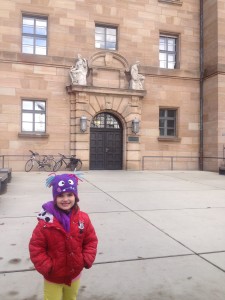
This museum (the Memorium Nürnberger Prozesse, visitor information here) includes both the courtroom itself and panels describing/depicting the Nazi war crimes and criminals. I linked the trials to the concentration camp: the bad people who hurt people because they were different, had to go to jail and court.
I explained that one important thing about this court was that other countries were bringing bad people in Germany to court because they saw bad things happening.
Sequoia was definitely confused about “Germany” being the bad guy. We live in Germany—we never complain about Germany. She goes to a German school, has German friends, speaks German, and lives in a small German town. All quite happily. How could “Germany” be doing something bad? I told her that this was a long time ago and that this wasn’t everyone in Germany, just some people. (This didn’t sink in with just one explanation—she asked where Germany sat at the prosecution’s table when she noticed the German flag missing.)
Most importantly for her experience, I stressed an outcome of the trials: future international courts such as The Hague. I explained that if one country sees people doing something wrong in another country, they can take them to courts like this one. So if America sees something bad going on in France, they can take someone to court; or if Germany sees something bad going on in America, they can take someone to court.
There was not much to focus a young child’s attention on in this museum, as it was mainly informative panels. I showed her the box that important information was kept in–important names and papers that they needed for court. One picture showed prisoners in a march. I explained that when the “different” people were rounded up, they had to march in a long line to the concentration camps, sometimes really far.
—
All children are different. One child might hear about families being separated and have nightmares, so taking them to even the innocuous-seeming border museum might not be a good idea. Other children have a higher tolerance for images they might see. I am not suggesting that every child is ready to visit these types of places. I do not advocate selfishly dragging children to these museums so that you get to see them whether the child is ready or not. I advocate dragging your kid to these museums for the same reason you drag your kid to museums of art and history: because you think they will gain something from it.
Sequoia has not fully absorbed this information by any means. We continue to build upon it with each visit. My personal goal at her age is that she understand that it is wrong to segregate or hurt people because they are different, and that we should be thinking about these things consciously and consistently.
For more information about some specific memorials, see what I added to this post for Germany, Ja.
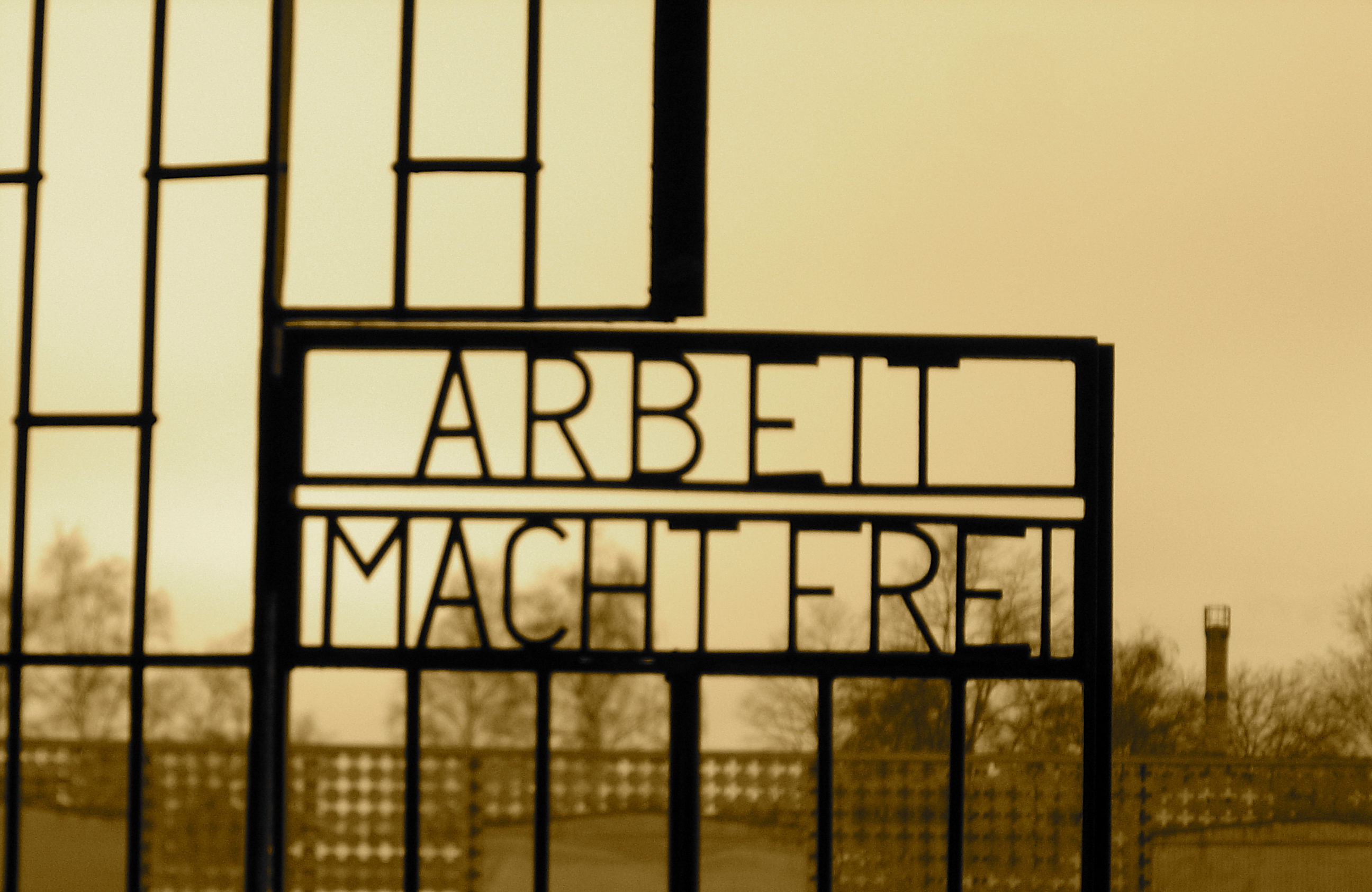

[…] Kari originally posted a version this article on her site, but has graciously shared it with us here as […]